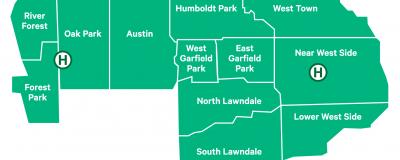Learn more about the West Side communities of Chicago that Rush serves, extending from the city’s Near West Side to the suburbs of Forest Park, Oak Park and River Forest.
Near West Side
The Near West Side, two miles west of the Loop, has been a diverse and densely populated neighborhood for nearly 200 years. The landscape of the neighborhood has changed dramatically since the mid-20th century, with the construction of the Circle interchange, the University of Illinois at Chicago and the United Center sports arena.
Lower West Side
Three miles southwest of the Loop, the Lower West Side includes two distinct neighborhoods: Pilsen, after the Czech city from which many of its early residents came, and Heart of Chicago. Beginning in the Great Depression and continuing through World War II and the 1950s, the neighborhood’s industrial anchors started to close down or move to the suburbs. Mexican-American families began to move into the area, which has evolved into the city’s primary point of entry for that immigrant group.
West Town
West Town, three miles northwest of the Loop, is “best understood as an amalgam of several distinct neighborhoods” that includes Humboldt Park, Noble Square, Ukrainian Village and Wicker Park. Wicker Park and Bucktown became popular with artists and students in the late 20th century. As restaurants, bars and shops proliferated and parts of the neighborhood began to gentrify, rising real estate costs displaced many lower-income residents to neighborhoods north and west.
East Garfield Park
Early in the 20th century, East Garfield Park was a neighborhood where thriving industry and well-kept single-family homes existed side by side — but the Great Depression and two world wars took their toll, with businesses closing and many homes converting to boardinghouses and apartments that grew overcrowded. When Blacks began to move into this community four miles west of the Loop in the 1950s, its racial makeup changed quickly as white residents and business owners hostile to the changes left; between 1950 and 2000, East Garfield Park lost more than two-thirds of its population.
Ending Food Deserts on Chicago's West Side | RUSH University System for Health

West Garfield Park
West Garfield Park, located five miles west of the Loop, is a community marked by change. Its evolution has encompassed the transition from farmland into what was for a time the city’s second busiest shopping district; attractions that have included both an infamous 19th-century racetrack and one of Chicago’s most beautiful parks; periods of booming residential growth followed by white flight; racial unrest and neighbors coming together.
North Lawndale
Less than three miles from the Loop, North Lawndale was roiled in the 1950s and '60s by tensions between new Black residents, who had difficulty finding work, and white workers who commuted in for jobs nearby. After the West Side riots of 1968, many businesses left and housing stock continued to decline as poverty, unemployment and crime grew.
South Lawndale
South Lawndale is the official name of this neighborhood located five miles southwest of the Loop, but the community is better known as La Villita/Little Village. Now the city’s largest Mexican neighborhood, it was settled by Czechs and Germans after the Chicago fire of 1871. The Mexican population grew throughout the late 20th century, particularly as people moved from neighborhoods that were disrupted by the construction of the University of Illinois at Chicago campus.
Austin
Seven miles west of the Loop on the western border of Chicago, Austin is the largest community area in the city in terms of both size and population. Long a middle-class community with many residents who commuted to work downtown, Austin’s demographic, like those of other West Side neighborhoods, began to shift in the 1960s from mostly white to mostly Black, although its population has not declined as much as others’.
Oak Park
First settled in 1835, the village of Oak Park — located eight miles west of the Loop — grew quickly when people moved out of Chicago after being displaced by the fire of 1871. By the 1920s, Oak Park had 40,000 residents and a thriving business district. In the 1960s, Oak Park residents and city leaders observed the white flight and subsequent resegregation that were taking place in Austin, its adjacent neighborhood to the east, and took concrete steps to prevent it happening in their community.
River Forest
Ten miles west of the Loop on the eastern bank of the Des Plaines River, River Forest grew from a settlement established near a sawmill in 1831 into one of the Chicago area’s most picturesque suburbs. Like its sister village of Oak Park, the community experienced growth after the Chicago fire of 1871, when displaced city residents moved west looking for a new place to settle. After the village made infrastructure improvements in the late 19th century, the population grew quickly.
Forest Park
Settled in the mid-19th century, Forest Park had become a leisure destination by the early 20th century, drawing people who traveled to the village’s amusement park, racetrack and golf course. The village’s total population has remained relatively stable for the last century, although its demographics have changed; nearly 100% white in 1900, Forest Park is now about 47% white, 33% Black and 10% Hispanic/Latinx.

